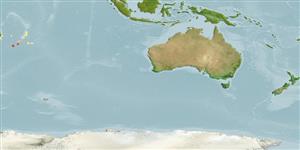Teleostei (teleosts) >
Ovalentaria/misc (Various families in series Ovalentaria) >
Pseudochromidae (Dottybacks) > Anisochrominae
Etymology: Anisochromis: Greek, anisos = unequal + Greek, chromis = a marine fish without identification, dealing with perch; cited by Plinius (Ref. 45335); mascarenensis: Named for its distribution (Mascarene Is.).
More on authors: Gill & Fricke.
Environment: milieu / climate zone / depth range / distribution range
Ecology
Marine; reef-associated; depth range 0 - 18 m (Ref. 42958). Tropical
Western Indian Ocean.
Size / Weight / Age
Maturity: Lm ? range ? - ? cm
Max length : 2.5 cm SL male/unsexed; (Ref. 42958)
Short description
Identification keys | Morphology | Morphometrics
Dorsal spines (total): 1; Dorsal soft rays (total): 25 - 26; Anal spines: 1; Anal soft rays: 17 - 18. Dorsal fin of males pale when preserved, with a large dark spot distally on anterior part of fin. Caudal vertebrae, 23-24 (usually 24). Lateral line scales usually 42-44. Posterior interorbital pores 34; total parietal pores 23-44, usually more than 30 (Ref. 42958).
Collected from lagoon reefs with live and dead corals; usually at the base of live, branched Acropora (Ref. 42958).
Life cycle and mating behavior
Maturity | Reproduction | Spawning | Eggs | Fecundity | Larvae
Gill, A.C. and R. Fricke, 2001. Revision of the Western Indian ocean fish subfamily Anisochrominae (Perciformes, Pseudochromidae). Bull. Nat. Hist. Mus. Lond. (Zool.) 67(2):191-207. (Ref. 42958)
IUCN Red List Status (Ref. 130435: Version 2024-1)
Threat to humans
Harmless
Human uses
Tools
Special reports
Download XML
Internet sources
Estimates based on models
Preferred temperature (Ref.
123201): 25.4 - 27.5, mean 25.9 °C (based on 19 cells).
Phylogenetic diversity index (Ref.
82804): PD
50 = 0.6250 [Uniqueness, from 0.5 = low to 2.0 = high].
Bayesian length-weight: a=0.01000 (0.00244 - 0.04107), b=3.04 (2.81 - 3.27), in cm total length, based on all LWR estimates for this body shape (Ref.
93245).
Trophic level (Ref.
69278): 3.5 ±0.57 se; based on food items.
Fishing Vulnerability (Ref.
59153): Low vulnerability (10 of 100).
